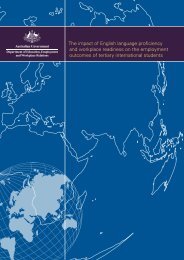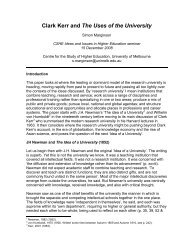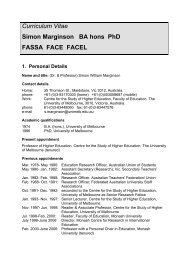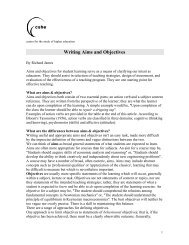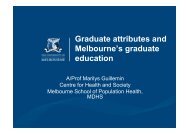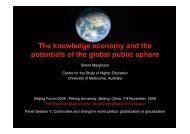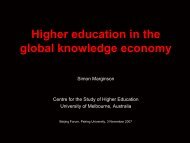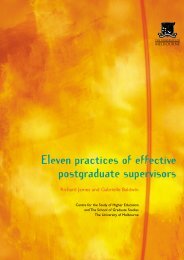The preparation of Mathematics Teachers in Australia - ACDS
The preparation of Mathematics Teachers in Australia - ACDS
The preparation of Mathematics Teachers in Australia - ACDS
Create successful ePaper yourself
Turn your PDF publications into a flip-book with our unique Google optimized e-Paper software.
Chapter 6: <strong>Mathematics</strong> teachers – demographic characteristics<br />
and employment histories<br />
<strong>The</strong> preced<strong>in</strong>g three chapters describe the pattern <strong>of</strong> mathematics teach<strong>in</strong>g <strong>in</strong> schools (Chapter 3),<br />
the views <strong>of</strong> heads regard<strong>in</strong>g tertiary <strong>preparation</strong> <strong>of</strong> mathematics teachers (Chapter 4) and teachers’<br />
tertiary qualifications as provided by teachers themselves (Chapter 5). This chapter looks <strong>in</strong> more<br />
detail at who is teach<strong>in</strong>g mathematics – the age and gender characteristics <strong>of</strong> mathematics teachers,<br />
and their pathways to teach<strong>in</strong>g as a career. <strong>The</strong>ir career plans are discussed further <strong>in</strong> Chapter 7.<br />
Chapter 6 has the follow<strong>in</strong>g structure:<br />
Section 6.1 - state/territory, sector and ARIA representation <strong>in</strong> the dataset <strong>of</strong> teacher responses.<br />
While some <strong>of</strong> this <strong>in</strong>formation also appears <strong>in</strong> Chapter 2, the emphasis here is on teacher rather than<br />
school representation.<br />
Section 6.2 - the age and gender characteristics <strong>of</strong> the 2924 teachers surveyed. State/territory and<br />
sector-based differences are also discussed. A comparison is made with national statistics for the age<br />
<strong>of</strong> teachers generally (i.e. all discipl<strong>in</strong>es), as reported elsewhere.<br />
Section 6.3 – the employment histories <strong>of</strong> mathematics teachers, <strong>in</strong>clud<strong>in</strong>g years <strong>of</strong> teach<strong>in</strong>g<br />
experience and details <strong>of</strong> previous employment.<br />
Section 6.4 – characteristics <strong>of</strong> teachers grouped accord<strong>in</strong>g to teach<strong>in</strong>g responsibilities.<br />
In summary:<br />
- <strong>The</strong> average age <strong>of</strong> mathematics teachers was 44.0 years, with a median <strong>of</strong> 46 years.<br />
- Thirty-eight per cent <strong>of</strong> teachers were over 49 years <strong>of</strong> age, and fifteen per cent over the age<br />
<strong>of</strong> 54 years <strong>of</strong> age.<br />
- Nearly equivalent numbers <strong>of</strong> responses were received from male and female teachers<br />
nationally.<br />
- Male teachers represented 58 per cent <strong>of</strong> responses from South <strong>Australia</strong>.<br />
- One <strong>in</strong> three teachers had less than ten years teach<strong>in</strong>g experience, and 17 per cent had been<br />
teach<strong>in</strong>g for fewer than five years.<br />
- Male teachers were older (median age 49 years) and more experienced than female<br />
teachers.<br />
- Teach<strong>in</strong>g was the first pr<strong>of</strong>ession for three out <strong>of</strong> four mathematics teachers.<br />
- <strong>Teachers</strong> <strong>of</strong> junior school mathematics were, on average, younger and less experienced than<br />
their colleagues.<br />
- <strong>Teachers</strong> <strong>of</strong> advanced senior mathematics are most likely to be male, highly experienced and<br />
among the least likely to teach non-mathematics subjects.<br />
6.1 Location and sector representation <strong>in</strong> mathematics teachers survey<br />
Response to the survey <strong>of</strong> teachers was received from all eight states and territories, each <strong>of</strong> the<br />
three school sectors (Catholic, Government and Independent), and all ARIA categories.<br />
Twenty-eight per cent <strong>of</strong> the nation’s secondary schools were represented, with representation<br />
rang<strong>in</strong>g from 20 per cent (NT) to 36 per cent (SA) (Table 6.1). <strong>The</strong> large number <strong>of</strong> responses from<br />
Victoria and New South Wales simply reflects the size <strong>of</strong> these school systems. <strong>The</strong> number <strong>of</strong><br />
schools represented is consistent with other states, as is the number <strong>of</strong> teachers respond<strong>in</strong>g per<br />
school 16 (Table 6.1).<br />
16<br />
<strong>The</strong> high number <strong>of</strong> teacher responses per school from Victoria and low number from NSW accords with the size <strong>of</strong><br />
mathematics departments (see Section 3.1.2)<br />
33



